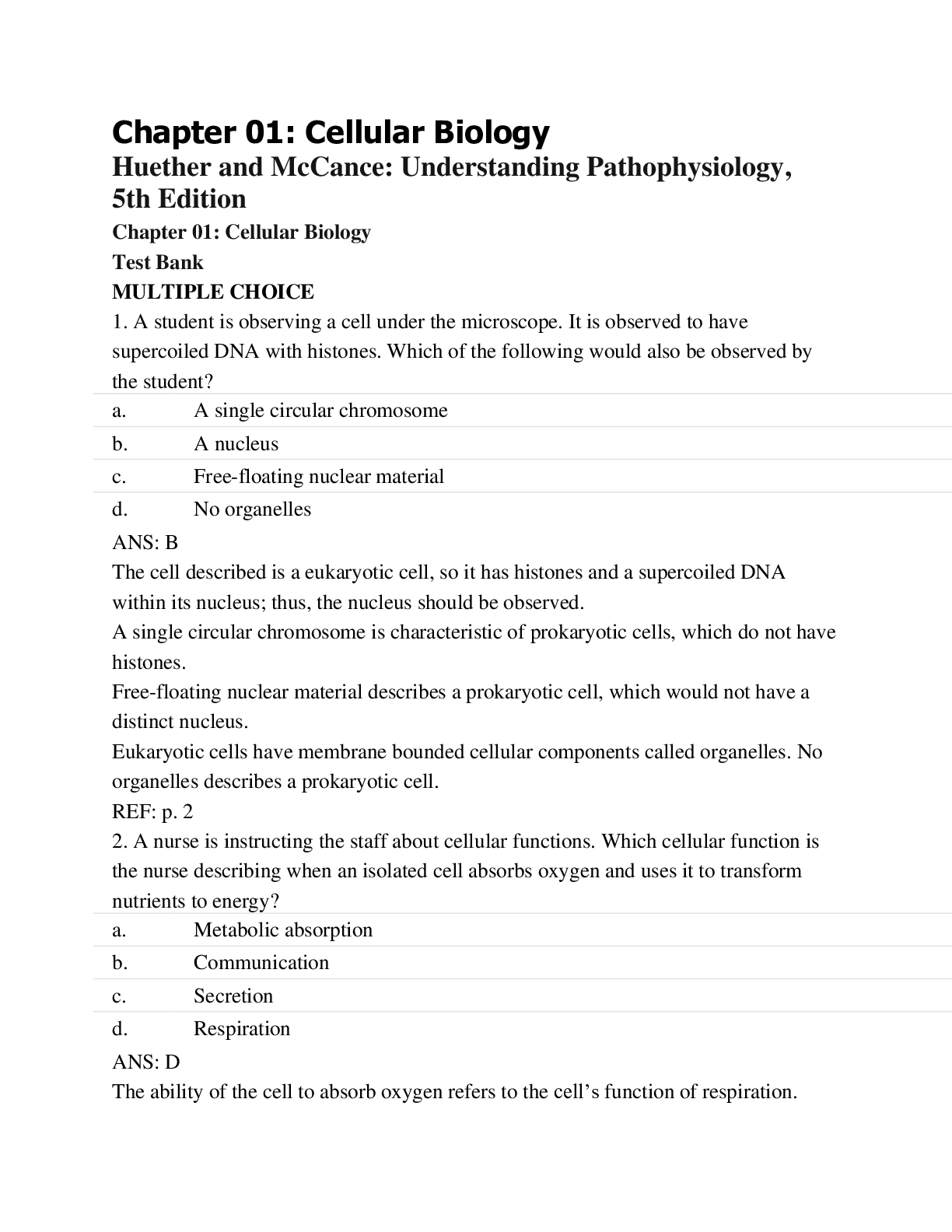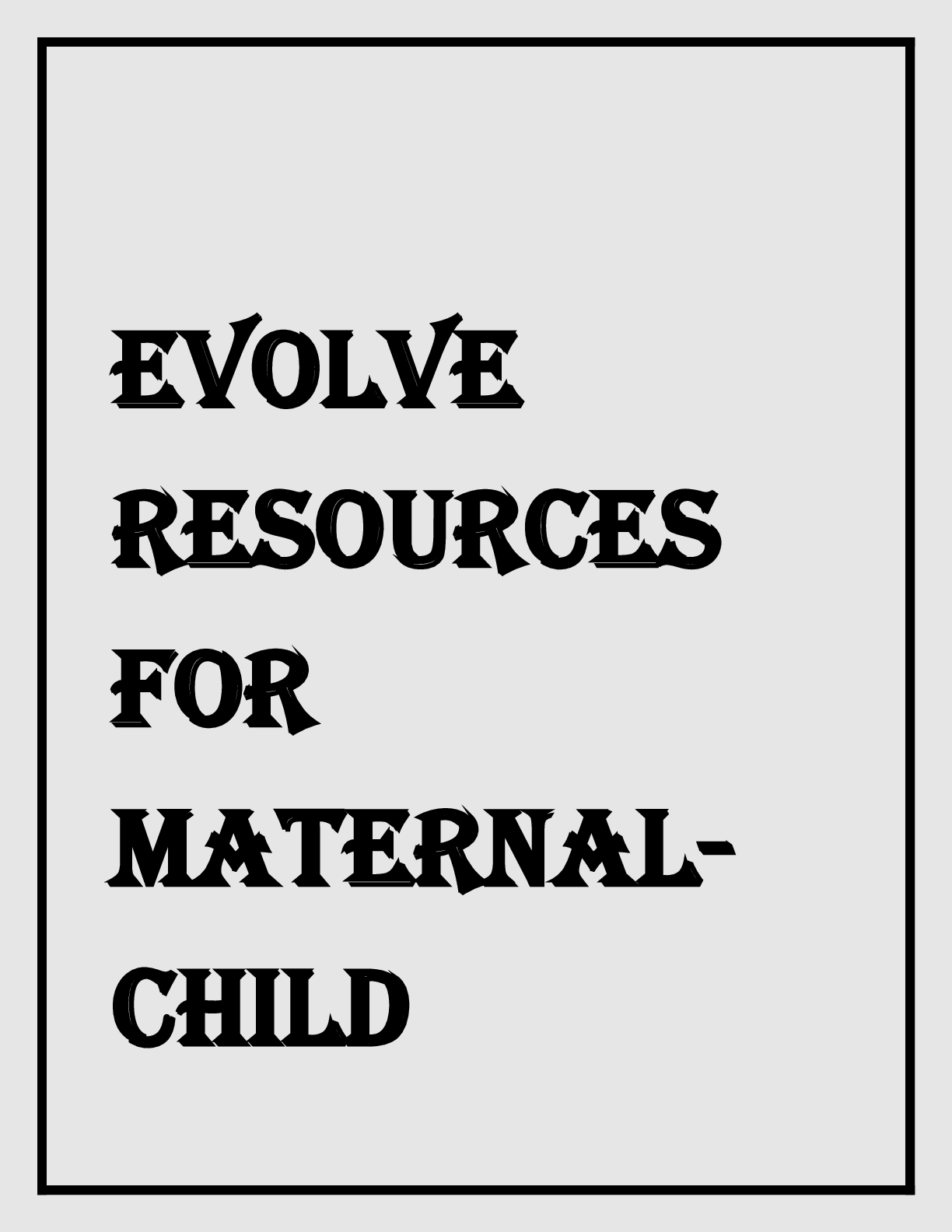*NURSING > TEST BANK > Huether and McCance: Understanding Pathophysiology, 5th Edition Test Bank ; all chapters (questions/ (All)
Huether and McCance: Understanding Pathophysiology, 5th Edition Test Bank ; all chapters (questions/answers/rationales)
Document Content and Description Below
Chapter 01: Cellular Biology Huether and McCance: Understanding Pathophysiology, 5th Edition Chapter 01: Cellular Biology Test Bank MULTIPLE CHOICE 1. A student is observing a cell under the mic... roscope. It is observed to have supercoiled DNA with histones. Which of the following would also be observed by the student? a. A single circular chromosome b. A nucleus c. Free-floating nuclear material d. No organelles ANS: B The cell described is a eukaryotic cell, so it has histones and a supercoiled DNA within its nucleus; thus, the nucleus should be observed. A single circular chromosome is characteristic of prokaryotic cells, which do not have histones. Free-floating nuclear material describes a prokaryotic cell, which would not have a distinct nucleus. Eukaryotic cells have membrane bounded cellular components called organelles. No organelles describes a prokaryotic cell. REF: p. 2 2. A nurse is instructing the staff about cellular functions. Which cellular function is the nurse describing when an isolated cell absorbs oxygen and uses it to transform nutrients to energy? a. Metabolic absorption b. Communication c. Secretion d. Respiration ANS: D The ability of the cell to absorb oxygen refers to the cell’s function of respiration. The ability of the cell to function within a society of cells refers to its function of communication. The ability of the cell to take in nutrients refers to the cell’s function of metabolic absorption. The ability of the cell to synthesize new substances and secrete these elsewhere refers to the cell’s function of secretion. REF: p. 3 3. A eukaryotic cell is undergoing DNA replication. In which region of the cell would most of the genetic information be contained? a. Mitochondria b. Ribosome c. Nucleolus d. Nucleus ANS: C The region of the cell that contains genetic material, including a large amount of ribonucleic acid, most of the DNA, and DNA-binding proteins, is the nucleolus. The mitochondria is the site of cellular respiration. The ribosomes are involved in manufacturing of proteins within the cell. The nucleus contains the nucleolus, and it is the nucleolus that contains genetic material. REF: p. 5 4. The fluid mosaic model for biologic membranes describes membrane behavior. According to this model, which of the following float singly or as aggregates in the fluid lipid bilayer? a. Peripheral membrane proteins b. Integral membrane proteins c. Glycoproteins d. Cell adhesion molecules ANS: B Integral membrane proteins float freely in the fluid lipid bilayer. Peripheral membrane proteins are not embedded in the layer, but reside at the surface. Glycoproteins act as cell surface markers. Cell adhesion molecules are on the outside of the membrane and allow cells to hook together. REF: p. 6 5. Which of the following can bind to plasma membrane receptors? a. Oxygen b. Ribosomes c. Amphipathic lipids d. Ligands ANS: D Ligands are specific molecules that can bind with receptors on the cell membrane. Oxygen moves by diffusion; it does not bind to receptors. Ribosomes make proteins and are not involved in binding. Amphipathic lipids are a portion of the cell membrane. REF: p. 11 6. A nurse is reviewing a report from a patient with metastatic cancer. What finding would support the diagnosis of metastatic cancer? Alterations in extracellular matrix that include: a. Decreased fibronectin b. Increased collagen c. Decreased elastin d. Increased glycoproteins ANS: A Reduced amounts of fibronectin are found in some types of cancerous cells, allowing cancer cells to travel, or metastasize. Collagen provides strength, and its breakdown is associated with osteoarthritis, not cancer. Elastin is found in the lungs and allows tissues to stretch; it is not associated with cancerous cells. Decreased, not increased, glycoproteins are associated with cancerous cells. REF: p. 8 7. Which form of cell communication is used to relate to other cells in direct physical contact? a. Cell junction b. Gap junction c. Desmosomes d. Tight junctions ANS: A Cell junctions hold cells together and permit molecules to pass from cell to cell. Gap junctions allow communication from the inside of one cell to the inside of another. Desmosomes are not involved in communication, but allow cells to hold together. Tight junctions are barriers that prevent movement of some substances and leakages of others. REF: p. 9 8. Pancreatic beta cells secrete insulin, which inhibits secretion of glucagon from neighboring alpha cells. This action is an example of which of the following signaling types? a. Paracrine b. Autocrine c. Neurohormonal d. Hormonal ANS: A Paracrine signaling involves the release of local chemical mediators that are quickly taken up, destroyed, or immobilized, as in the case of insulin and the inhibition of the secretion of glucagon. When cells produce signals that they themselves respond to, autocrine signaling is used. Neurohormonal signaling involves secretion of hormones into the bloodstream by neurosecretory hormones. Hormonal signaling involves specialized endocrine cells that secrete hormone chemicals released by one set of cells that travel through the tissue through the bloodstream to produce a response in other sets of cells. REF: p. 11 9. In cellular metabolism, each enzyme has a high affinity for a: a. Solute b. Substrate c. Receptor d. Ribosome ANS: B Each enzyme has a high affinity for a substrate, a specific substance converted to a product of the reaction. Solutes are small particles that pass through the cell membrane. A receptor is a site on the cell wall that allows transport into the cell. Ribosomes are located inside the cell and are not related to the work of enzymes. REF: p. 13 10. An athlete runs a marathon, after which his muscles feel fatigued and unable to contract. The athlete asks the nurse why this happened. How should the nurse respond? A deficiency in ________ can cause impaired muscle contraction. a. GTP b. AMP c. ATP d. GMP ANS: C The cell uses ATP for muscle contraction. when it is deficient, impaired muscle contraction results. GTP is involved in cell signaling, not muscle contraction. AMP is not involved in muscle contraction. GMP is not involved in muscle contraction. REF: p. 13 11. Which phase of catabolism produces the most ATP? a. Digestion b. Glycolysis c. Oxidation d. Citric acid cycle ANS: D Most of the ATP is generated during the citric acid cycle. Larger molecules are broken down into smaller units during digestion; no ATP is produced during this cycle. During glycolysis, two molecules of ATP are produced from each glucose molecule, but the most ATP is produced during the citric acid cycle. Oxidation is part of the glycolysis process and ATP is produced, but more ATP is produced during the citric acid cycle. REF: p. 13 12. A nurse is teaching the staff about the three phases of cellular catabolism. Which of the following should the nurse include? a. Digestion, glycolysis and oxidation, and the citric acid cycle b. Diffusion, osmosis, and mediated transport c. S phase, G phase, and M phase d. Metabolic absorption, respiration, and excretion ANS: A Digestion, glycolysis and oxidation, and the citric acid cycle are the three phases of cellular catabolism. Diffusion, osmosis, and mediated transport are parts of the movement of fluids in and out of cells. The S, G, and M phases are phases of cellular division, not catabolism. Metabolic absorption, respiration, and excretion are functions of the cell. REF: p. 13 13. A runner has depleted all the oxygen available for muscle energy. Which of the following will facilitate his continued muscle performance? a. Electron-transport chain b. Aerobic glycolysis c. Anaerobic glycolysis d. Oxidative phosphorylation ANS: C When no oxygen is available, anaerobic glycolysis occurs. The electron-transport chain is part of the citric acid cycle. Aerobic glycolysis involves the presence of oxygen. Oxidative phosphorylation is the mechanism by which the energy produced from carbohydrates, fats, and proteins is transferred to ATP. It is not part of muscle performance. REF: p. 14 14. The faculty member asked the student to identify the appropriate term for the movement of small, electrically uncharged molecules through a semipermeable barrier. Which answer indicates the nursing student understood the teaching? a. Osmosis b. Diffusion c. Hydrostatic pressure d. Active transport ANS: B Diffusion is the movement of a solute molecule from an area of greater solute concentration to an area of lesser solute concentration. Osmosis is the movement of water across a semipermeable membrane from a region of higher water concentration to one of lower concentration. Hydrostatic pressure is the force of fluid against a cell membrane. Within the vascular system, this pressure is the blood pressure. In active transport, molecules move up a concentration gradient. This process requires energy. REF: p. 15 15. A nurse is teaching a patient about fluid and electrolytes. Which of the following indicates the teaching was successful regarding electrolytes? Electrolytes are: a. Small lipid-soluble molecules b. Large protein molecules c. Micronutrients used to produce ATP d. Electrically charged molecules ANS: D Electrolytes are electrically charged molecules. Electrolytes are not lipid soluble. Electrolytes are not made up of protein. Electrolytes do not have a role in the production of ATP. REF: p. 15 16. A nurse is reading a chart and sees the term oncotic pressure. The nurse recalls that oncotic pressure (colloid osmotic pressure) is determined by: a. Concentration of sodium b. Plasma proteins c. Hydrostatic pressure d. Availability of membrane transporter proteins ANS: B Oncotic pressure is determined by the effect of colloids or plasma proteins. The concentration of sodium plays a role in tonicity. Hydrostatic pressure is the force within a vessel. Membrane transporter proteins are involved in active transport within a concentration gradient. REF: p. 16 17. A patient has a body fluid of 300 mOsm/kg. This lab result is measuring: a. Osmolality b. Osmolarity c. Osmotic pressure d. Oncotic pressure ANS: A Osmolality measures the number of milliosmoles per kilogram of water, or the concentration of molecules per weight of water. Osmolarity measures the number of milliosmoles per liter of solution, or the concentration of molecules per volume of solution. Osmotic pressure is the amount of hydrostatic pressure required to oppose the osmotic movement of water. Oncotic pressure is from plasma proteins, not body fluids. REF: p. 16 18. In teaching a patient with cirrhosis, which information should the nurse include regarding cholesterol? a. Cholesterol decreases the membrane fluidity of the erythrocyte, which reduces its ability to b. Cholesterol decreases the membrane fluidity of erythrocytes, which reduces its ability to ca c. Cholesterol increases the membrane fluidity of erythrocytes, which allows binding of exce d. Cholesterol increases the membrane fluidity of erythrocytes, which prolongs its life span b ANS: A In cirrhosis, the cholesterol content of the red blood cell’s plasma membrane increases, causing a decrease in membrane fluidity that seriously affects the cell’s ability to transport oxygen. In cirrhosis, for example, the cholesterol content of the red blood cell’s plasma membrane increases, causing a decrease in membrane fluidity that seriously affects the cell’s ability to transport oxygen, not hemoglobin; the hemoglobin carries the oxygen. In cirrhosis, for example, the cholesterol content of the red blood cell’s plasma membrane increases, causing a decrease in membrane fluidity that seriously affects the cell’s ability to transport oxygen; it does not bind excess glucose. In cirrhosis, for example, the cholesterol content of the red blood cell’s plasma membrane increases, causing a decrease in membrane fluidity that seriously affects the cell’s ability to transport oxygen. It does not prolong the life of the RBC and could decrease it. REF: p. 7 19. A nurse is discussing the movement of fluid across the arterial end of capillary membranes into the interstitial fluid surrounding the capillary. Which process of fluid movement is the nurse describing? a. Hydrostatic pressure b. Osmosis c. Diffusion d. Active transport ANS: A Blood reaching the capillary bed has a hydrostatic pressure of 25 to 30 mm Hg, which is sufficient force to push water across the thin capillary membranes into the interstitial space. Osmosis involves the movement of fluid from an area of higher concentration to an area of lower concentration. It does not involve pressure or force. It is related to hydrostatic pressure. Diffusion is the passive movement of a solute from an area of higher solute concentration to an area of lower solute concentration. Active transport involves movement up a concentration gradient. REF: p. 16 20. A patient who has diarrhea receives a hypertonic saline solution intravenously to replace the sodium and chloride lost in the stool. What effect will this fluid replacement have on cells? a. Cells will become hydrated. b. Cells will swell or burst. c. Cells will shrink. d. Cells will divide. ANS: C The hypertonic saline will cause fluid to leave the intracellular space and enter the vascular space, causing cells to shrink. Intravenous hypertonic solutions lead to cell dehydration. Intravenous hypertonic solutions cause fluid to leave cells; thus, they would shrink, not swell. Intravenous hypertonic solutions do not affect cellular division. REF: p. 17 21. A nurse is teaching a patient with diabetes how glucose is transported from the blood to the cell. What type of transport system should the nurse discuss with the patient? a. Active-mediated transport (active transport) b. Active diffusion c. Passive osmosis d. Passive-mediated transport (facilitated diffusion) ANS: D A well-known passive-mediated transport system is that for glucose in erythrocytes (red blood cells). The transport of glucose does not require energy, so active-mediated transport is not correct. The transport of glucose does not require energy, so active diffusion is not correct. Osmosis involves the movement of water. REF: p. 17 22. How are potassium and sodium transported across plasma membranes? a. By passive electrolyte channels b. By coupled channels c. By adenosine triphosphate enzyme (ATPase) d. By diffusion ANS: C A “carrier” mechanism in the plasma membrane mediates the transport of ions and nutrients. The best-known pump is the Na+-K+–dependent ATPase pump. Electrolyte movements require energy and do not move passively. Enzymes, not electrolytes, are passed via coupled channels. Electrolytes are not transported by diffusion. REF: p. 17 23. Why is potassium able to diffuse easily in and out of cells? a. Because potassium has a greater concentration in the intracellular fluid (ICF) b. Because sodium has a greater concentration in the extracellular fluid (ECF) c. Because the resting plasma membrane is more permeable to potassium d. Because there is an excess of anions inside the cell ANS: C The resting membrane is more permeable to potassium because potassium is more easily transported inward. Potassium is greater in concentration in the ICF, but this is not why it is transported more easily. Sodium does have a greater concentration, but this is not why potassium moves easily when the membrane potential is at rest. It is cations, not anions, that are involved in membrane potential activity. REF: p. 18 24. The ion transporter that moves Na+ and Ca2+ simultaneously in the same direction is an example of which of the following types of transport? a. Biport b. Uniport c. Antiport d. Symport ANS: D When ions are transported in one direction, it is termed symport. There is no such term as biport. Uniport refers to the movement of a single molecule. Antiport refers to movement of molecules in the opposite direction. REF: p. 17 25. During which process can lysosomal enzymes be released to degrade engulfed particles? a. Endocytosis b. Pinocytosis c. Phagocytosis d. Exocytosis ANS: C Engulfment of particles occurs by phagocytosis. Endocytosis involves the formation of vesicles to facilitate movement into the cell. Pinocytosis is a type of endocytosis in which fluids and solute molecules are ingested through formation of small vesicles. Exocytosis occurs when coated pits invaginate and internalize ligand-receptor complexes in coated vesicles. REF: p. 20 26. A nurse is teaching the staff about cholesterol. Which information should be taught? The cellular uptake of cholesterol depends on: a. Active-mediated transport b. The antiport system c. Receptor-mediated endocytosis d. Passive transport ANS: C The cellular uptake of cholesterol depends on receptor-mediated endocytosis. The cellular uptake of cholesterol depends on receptor-mediated endocytosis; it is not dependent on active-mediated transport. The cellular uptake of cholesterol depends on receptor-mediated endocytosis; it is not a part of the antiport system. The cellular uptake of cholesterol depends on receptor-mediated endocytosis; it requires energy and is not passive in transport. REF: p. 20 27. Some cancer drugs work during the cell cycle phase where nuclear and cytoplasmic division occurs. What is this cell cycle phase called? a. G1 b. S c. M d. G2 ANS: C The M phase includes both nuclear and cytoplasmic division. The G1 phase includes the period between the M phase and the start of DNA synthesis. The S phase include synthesis of DNA in the cell nucleus. The G2 phase includes RNA and protein synthesis. REF: p. 23 28. What causes the rapid change in the resting membrane potential that initiates an action potential? a. Potassium gates open, and potassium rushes into the cell, changing the membrane potentia to positive. b. Sodium gates open, and sodium rushes into the cell, changing the membrane potential from positive. c. Sodium gates close, allowing potassium into the cell to change the membrane potential fro negative. d. Potassium gates close, allowing sodium into the cell to change the membrane potential fro negative. ANS: B When the threshold is reached, the cell will continue to depolarize with no further stimulation. The sodium gates open, and sodium rushes into the cell, causing the membrane potential to reduce to zero and then become positive (depolarization). Sodium is involved in creating the action potential, not potassium. The sodium gate must be open, not closed. The sodium channel must be open; this is not affected by a change in the potassium gate. REF: p. 21 29. A cell is isolated, and electrophysiology studies reveal that the resting membrane potential is –70 millivolts. The predominant intracellular ion is Na+, and the predominant extracellular ion is K+. With voltage change, which of the following would result in an action potential? a. K+ rushing into the cell b. Na+ rushing into the cell c. Na+ rushing out of the cell d. K+ rushing out of the cell ANS: A With voltage change, potassium rushes into the cell. Potassium, not sodium, rushes into the cell. Potassium, not sodium, is involved in the process, and potassium moves into the cells, not out. Potassium rushes into the cell, not out. REF: p. 22 30. A nurse is teaching the staff about platelet-derived growth factor. Which information should the nurse include? Platelet-derived growth factor (PDGF) stimulates the production of: a. Platelets b. Epidermal cells c. Connective tissue cells d. Fibroblast cells ANS: C Different types of cells require different growth factors; for example, PDGF stimulates the production of connective tissue cells. The factor stimulates the production of connective tissue, not platelets. The factor stimulates the production of connective tissue, not epidermal cells. The factor stimulates the production of connective tissue, not fibroblast cells. REF: p. 24 31. The phase of the cell cycle during which the centromeres split and the sister chromatids are pulled apart is referred to as: a. Anaphase b. Telophase c. Prophase d. Metaphase ANS: A Anaphase begins when the centromeres split and the sister chromatids are pulled apart. During telophase, the final stage, a new nuclear membrane is formed around each group of 46 chromosomes, the spindle fibers disappear, and the chromosomes begin to uncoil. During prophase, the first appearance of chromosomes occurs. Metaphase occurs when two centrioles located at opposite poles of the cell pull the chromosomes to opposite sides of the cell. REF: p. 23 32. What is the role of cytokines in cell reproduction? a. Provide growth factor for tissue growth and development b. Block progress of cell reproduction through the cell cycle c. Restrain cell growth and development d. Provide nutrients for cell growth and development ANS: A Cytokines play a major role in the regulation of tissue growth and development. Cytokines help overcome intracellular braking mechanisms that restrain cell growth. Cytokines promote cell growth, not restrain it. Cytokines regulate growth; they do not provide nutrients. REF: p. 23 33. A biopsy of the lung bronchi revealed ciliated epithelial cells that are capable of secretion and absorption. These cells are called _____ columnar epithelium. a. Simple b. Ciliated simple c. Stratified d. Pseudostratified ciliated ANS: B Ciliated simple columnar epithelium are found in the lungs. Simple columnar epithelium are found from the stomach to the anus. Stratified columnar epithelium are found in the linings of epiglottis, part of pharynx, anus, and male urethra. Pseudostratified ciliate columnar epithelium is found in the linings of large ducts of some glands (parotid, salivary), male urethra, respiratory passages, and eustachian tubes of ears. REF: p. 26 34. The nurse would be correct in identifying the predominant extracellular cation as: a. Sodium b. Potassium c. Chloride d. Glucose ANS: A The predominant extracellular cation is sodium. Potassium is the predominant intracellular cation. Chloride is an anion. Urea is a nonelectrolyte. Glucose is a nonelectrolyte. REF: p. 20 35. The student is reviewing functions of the cell. The student would be correct in identifying the primary function of the nerve cell as: a. Sensory interpretation b. Conductivity c. Maintenance of homeostasis d. Communication ANS: B Conduction as a response to a stimulus is manifested by a wave of excitation; an electrical potential that passes along the surface of the cell to reach its other parts. Conductivity is the chief function of nerve cells. Nerve cells assist with sensory interpretation, but their primary function is conductivity. Nerve cells assist with maintenance of homeostasis, but their primary function is conductivity. Nerve cells assist with communication, but their primary function is conductivity. REF: p. 2 36. The student is studying for a pathophysiology exam and is trying to remember the definition of amphipathic. The student should choose which of the following to be correct? a. All cells have a membrane that is composed of lipids. b. Cells have organelles that have specialized function. c. Molecules are polar with one part loving water and one part hating water. d. Cells have receptor sites that other substances attach to and create additional functions. ANS: C Amphipathic means that one part is hydrophobic (uncharged, or “water hating”) and another part is hydrophilic (charged, or “water loving”). Cells have a membrane, but this is not the definition of amphipathic. Cells have organelles, but this is not the definition of amphipathic. Cells have receptor sites, but this is not the definition of amphipathic. REF: p. 3 MULTIPLE RESPONSE 1. A nurse recalls that the four basic types of tissues are (select all that apply): a. Nerve b. Epithelial c. Mucosal d. Connective e. Skeletal f. Muscle ANS: A, B, D, F Nerve is one of the four basic tissue types. Epithelial is one of the four basic tissue types Connective is one of the four basic tissue types. Muscle is one of the basic tissue types. Mucosal is a type of epithelial cell and is not a basic tissue type. Skeletal is a type of connective tissue and is not a basic tissue type. REF: p. 24 2. Characteristics of prokaryotes include which of the following? (Select all that apply.) a. They contain no organelles. b. Their nuclear material is not encased by a nuclear membrane. c. They contain a distinct nucleus. d. They contain histones. e. They contain a cellular membrane. ANS: A, B The prokaryotes contain no organelles. The prokaryotic cells do not have their nuclear materials encased by a nuclear membrane. Prokaryotic cells are characterized by lack of a distinct nucleus. Prokaryotes lack a class of proteins called histones, which in eukaryotic cells bind with DNA and are involved in the supercoiling of DNA. Prokaryotic cells do not have a cellular membrane. REF: p. 2 Chapter 02: Genes and Genetic Diseases Huether and McCance: Understanding Pathophysiology, 5th Edition Chapter 02: Genes and Genetic Diseases Test Bank MULTIPLE CHOICE 1. A nurse recalls the basic components of DNA are: a. Pentose sugars and four phosphate bases b. A phosphate molecule, deoxyribose, and four nitrogenous bases c. Adenine, guanine, and purine d. Codons, oxygen, and cytosine ANS: B DNA has three basic components: the pentose sugar molecule, deoxyribose; a phosphate molecule; and four types of nitrogenous bases. DNA contains four nitrogenous bases, not phosphate bases. Adenine and quinine are purines and are only a portion of the components of DNA. DNA synthesizes body protein, of which a codon is a component. REF: p. 35 2. Which of the following mutations have the most significant effect on protein synthesis? a. Base pair substitutions b. Silent mutations c. Intron mutations d. Frameshift mutations ANS: D The frameshift mutation involves the insertion or deletion of one or more base pairs of the DNA molecule. They alter the amino acid sequence. The base pair substitution is a type of mutation in which one base pair replaces another. Silent mutations do not change amino acids or protein synthesis. Intron mutations are part of RNA sequencing. REF: p. 37 3. The base components of DNA are: a. A, G, C, and U b. P, G, C, and T c. A, G, C, and T d. X, XX, XY, and YY ANS: C The four base components of DNA are cytosine, thymine, adenine, and guanine and are commonly represented by their first letters: A, C, T, and G. The four base components of DNA are cytosine, thymine, adenine, and guanine and are commonly represented by their first letters: A, C, T, and G. U is not included. The four base components of DNA are cytosine, thymine, adenine, and guanine and are commonly represented by their first letters: A, C, T, and G. P is not included. X, XX, XY and YY are components of human chromosomes. REF: p. 35 4. A DNA strand has a region with the sequence ATCGGAT. Which of the following would be a complementary strand? a. CGATACGT b. TAGCCTAG c. TUGCCTUG d. UAGCCUAG ANS: B The consistent pairing of adenine with thymine and of guanine with cytosine is known as complementary base pairing; thus, A complements to T and C to G and vice versa throughout the strand. A complements to T; thus, the first letter must be a T. U does not represent a complement in the sequence. U does not represent a complement in the sequence. REF: p. 35 5. A biologist is explaining how RNA directs the synthesis of protein. Which process is the biologist describing? a. Termination b. Transcription c. Translocation d. Translation ANS: D In translation, RNA directs the synthesis of a polypeptide, interacting with transfer RNA (tRNA), a cloverleaf-shaped strand of about 80 nucleotides. At a termination signal, translation and polypeptide formation cease. This does not involve synthesis of protein. Transcription is the process by which DNA specifies a sequence of messenger RNA (mRNA). Translocation is the interchange of genetic material between nonhomologous chromosomes. REF: p. 39 6. When homologous chromosomes fail to separate during meiosis, which of the following occurs? a. Neurofibromatosis b. Nondisjunction c. Polyploidy d. Conjoined twins ANS: B Nondisjunction is an error in which homologous chromosomes or sister chromatids fail to separate normally during meiosis or mitosis. Neurofibromatosis is a dominant disorder. It is not due to chromosome failure during meiosis. Polyploidy occurs when a euploid cell has more than the diploid number of chromosomes. Conjoined twins are not due to chromosome failure during meiosis. REF: p. 42 7. A cell that does not contain a multiple of 23 chromosomes is called a _____ cell. a. diploid b. euploid c. polyploid d. haploid ANS: C A polyploid cell is one in which a euploid cell has more than the diploid number of chromosomes. A diploid cell is when the somatic cell nucleus has 46 chromosomes in 23 pairs. A euploid cell is a cell with multiples of the normal number of chromosomes. A haploid cell has only one member of each chromosome pair, for a total of 23 chromosomes. REF: p. 39 8. A 20-year-old pregnant female gives birth to a stillborn child. Autopsy reveals that the fetus has 92 chromosomes. What term may be on the autopsy report to describe this condition? a. Biploidy b. Triploidy c. Tetraploidy d. Aneuploidy ANS: C Tetraploidy is a condition in which euploid cells have 92 chromosomes. Biploidy is a euploid cell with 2 times more chromosomes, or 46. Triploidy is a zygote that has three copies of each chromosome, rather than the usual two. Aneuploidy is when an aneuploid cell does not contain a multiple of 23 chromosomes. REF: p. 40 9. The condition in which an extra portion of a chromosome is present in each cell is called: a. Reciprocal translocation b. Partial trisomy c. Inversion d. Down syndrome ANS: B Partial trisomy is a condition in which only an extra portion of a chromosome is present in each cell. A reciprocal translocation occurs when breaks take place in two different chromosomes and the material is exchanged. An inversion occurs when two breaks take place on a chromosome, followed by the reinsertion of the missing fragment at its original site, but in inverted order. Down syndrome is an aneuploidy of the twenty-first chromosome. REF: p. 40 10. After a geneticist talks to the patient about being a chromosomal mosaic, the patient asks the nurse what that means. How should the nurse respond? You may _____ genetic disease(s). a. Only be a carrier of the b. Have a mild form of the c. Have two d. Be sterile as a result of the ANS: B A chromosomal mosaic means the body has two or more different cell lines, each of which has a different karyotype; thus, the person has a mild form of the disease. Mosaics are not only carriers; they have the disease. Mosaics have two different lines but not two different diseases. Mosaics are not sterile. REF: p. 42 11. The nurse is teaching staff about the most common cause of Down syndrome. What is the nurse describing? a. Paternal nondisjunction b. Maternal translocations c. Maternal nondisjunction d. Paternal translocations ANS: C The most common cause of Down syndrome is maternal nondisjunction. Down syndrome is not related to paternal nondisjunction. Down syndrome is related to the maternal side, but not due to translocation. Down syndrome is not related to paternal abnormalities. REF: p. 42 12. A patient wants to know the risk factors for Down syndrome. What is the nurse’s best response? a. Fetal exposure to mutagens in the uterus b. Increased paternal age c. Family history of Down syndrome d. Pregnancy in women over age 35 ANS: D The primary risk for Down syndrome is pregnancy in women over 35. Down syndrome is a trisomy and not due to fetal exposure. Paternal age is not a risk factor in Down syndrome. Down syndrome is a chromosomal abnormality and is not related to family history. REF: p. 42 13. A 13-year-old girl has a karyotype that reveals an absent homologous X chromosome with only a single X chromosome present. What medical diagnosis will the nurse observe on the chart? a. Down syndrome b. Cri du chat syndrome c. Turner syndrome d. Fragile X syndrome ANS: C A condition with the presence of a single X chromosome and no homologous X or Y chromosome, so the individual has a total of 45 chromosomes, is known as Turner syndrome. Down syndrome is a change in one arm of a chromosome. Cri du chat syndrome is due to a chromosome deletion. Fragile X syndrome is due to a break or a gap in a chromosome. REF: p. 43 14. An XXY person asks the nurse what this genetic disorder is called. What is the nurse’s best response? This disorder is _____ syndrome. a. Turner b. Klinefelter c. Down d. Fragile X ANS: B Individuals with at least two X chromosomes and one Y chromosome in each cell (47 XXY karyotype) have a disorder known as Klinefelter syndrome. A condition with the presence of a single X chromosome and no homologous X or Y chromosome, so the individual has a total of 45 chromosomes, is known as Turner syndrome. Down syndrome is a trisomy. Fragile X syndrome is due to a break or a gap in a chromosome, not an extra chromosome. REF: p. 43 15. A patient has severe mental retardation caused by a deletion of part of chromosome 5. What genetic disorder will the nurse see documented in the chart? a. Prader-Willi syndrome b. Down syndrome c. Cri du chat syndrome d. Trisomy X ANS: C Cri du chat syndrome means “cry of the cat” and describes the characteristic cry of the affected child. Another symptom of the disorder is mental retardation. Prader-Willi syndrome is characterized by short stature, obesity, and hypogonadism. Down syndrome does cause mental retardation, but is due to chromosome 21, not chromosome 5. Trisomy X can result in mental retardation, but is due to an extra X chromosome. REF: p. 43 16. A couple has three offspring: one child with an autosomal dominant disease trait and two who are normal. The father is affected by the autosomal dominant disease, but the mother does not have the disease gene. What is the recurrence risk of this autosomal dominant disease for their next child? a. 50% b. 33% c. 25% d. Impossible to determine ANS: A For each child with an autosomal dominant disease parent there is a 1 in 2, or 50%, risk. The risk is 50%. The risk is 50%. The risk can be determined and the risk is 50%. REF: p. 46 17. An aide asks the nurse why people who have neurofibromatosis will show varying degrees of the disease. Which genetic principle should the nurse explain to the aide? a. Penetrance b. Expressivity c. Dominance d. Recessiveness ANS: B Expressivity is the extent of variation in phenotype associated with a particular genotype. For neurofibromatosis, a variety of manifestations occur among individuals. The penetrance of a trait is the percentage of individuals with a specific genotype who also exhibit the expected phenotype. Dominance refers to observable traits and risk of transmission. Recessiveness refers to silent strains with reduced risk of occurrence. REF: p. 48 18. When a patient asks what causes cystic fibrosis, how should the nurse respond? Cystic fibrosis is caused by an _____ gene. a. X-linked dominant b. X-linked recessive c. Autosomal dominant d. Autosomal recessive ANS: D Cystic fibrosis is an autosomal recessive disorder. Cystic fibrosis is not X linked, but autosomal. Cystic fibrosis is not X linked, but recessive. Cystic fibrosis is not dominant. REF: p. 50 19. A 15-year-old female is diagnosed with Prader-Willi syndrome. This condition is an example of: a. Gene imprinting b. An autosomal recessive trait c. An autosomal dominant trait d. A sex-linked trait ANS: A Prader-Willi is an example of gene imprinting. ******CONTINUED***************** [Show More]
Last updated: 1 year ago
Preview 1 out of 651 pages
Instant download

Buy this document to get the full access instantly
Instant Download Access after purchase
Add to cartInstant download
Reviews( 0 )
Document information
Connected school, study & course
About the document
Uploaded On
Feb 10, 2021
Number of pages
651
Written in
Additional information
This document has been written for:
Uploaded
Feb 10, 2021
Downloads
0
Views
51


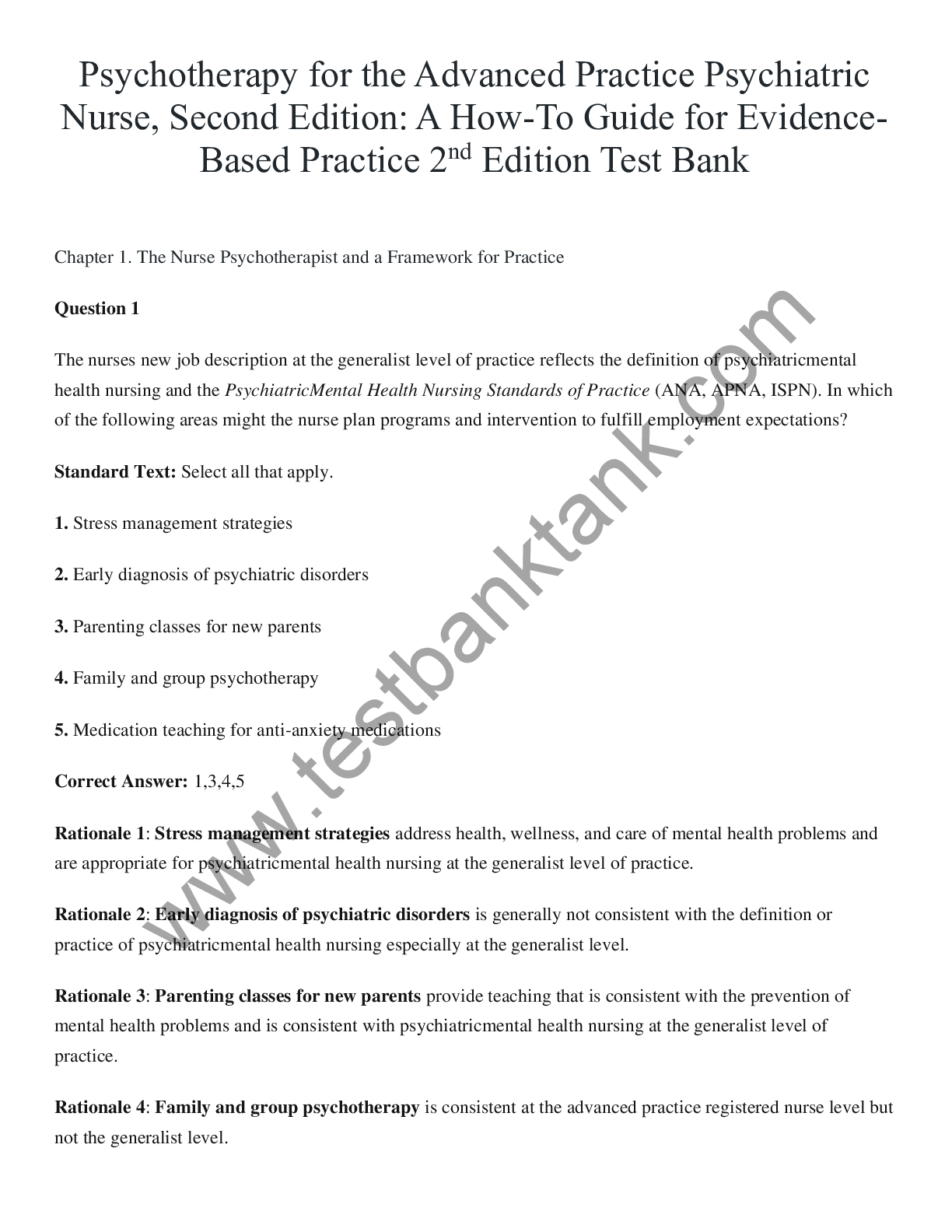


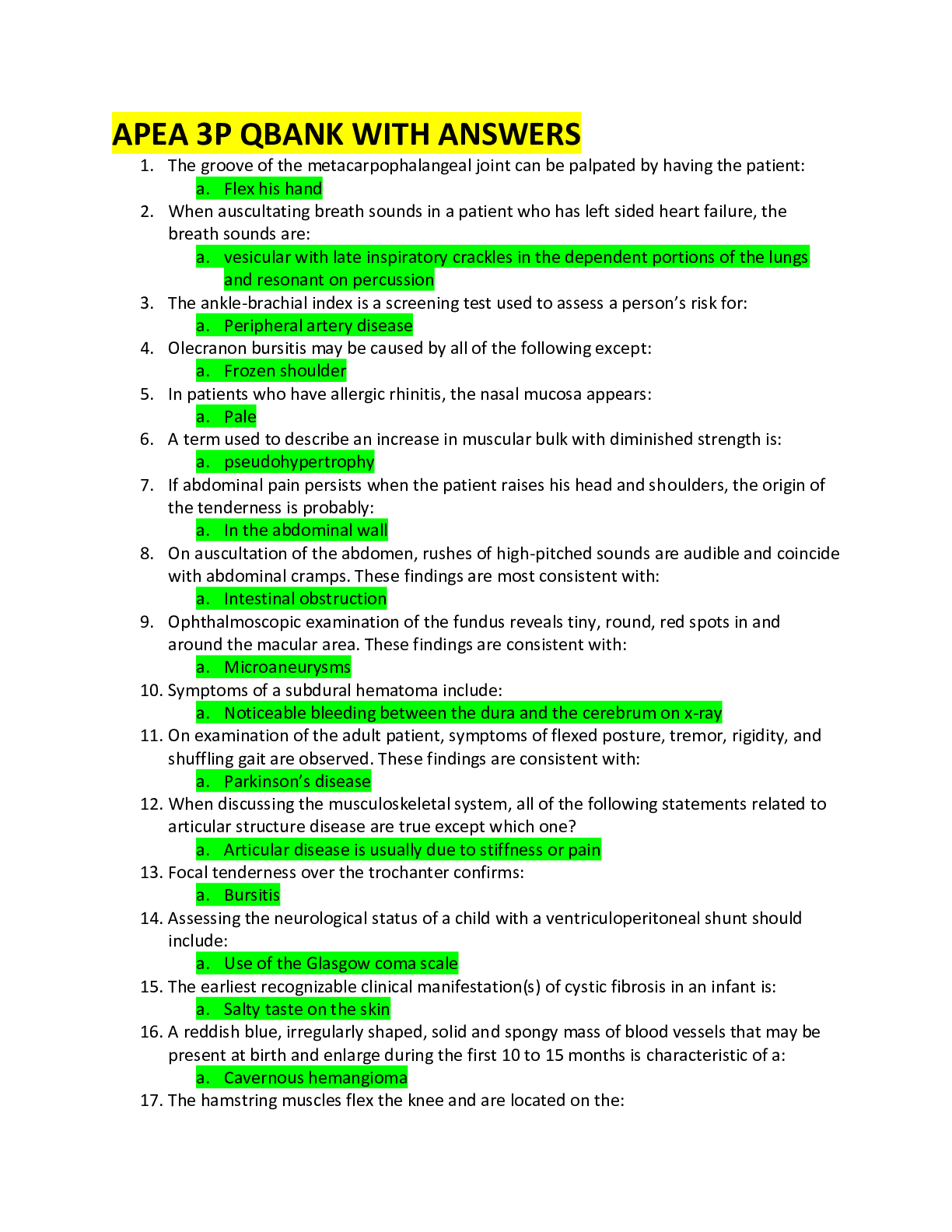




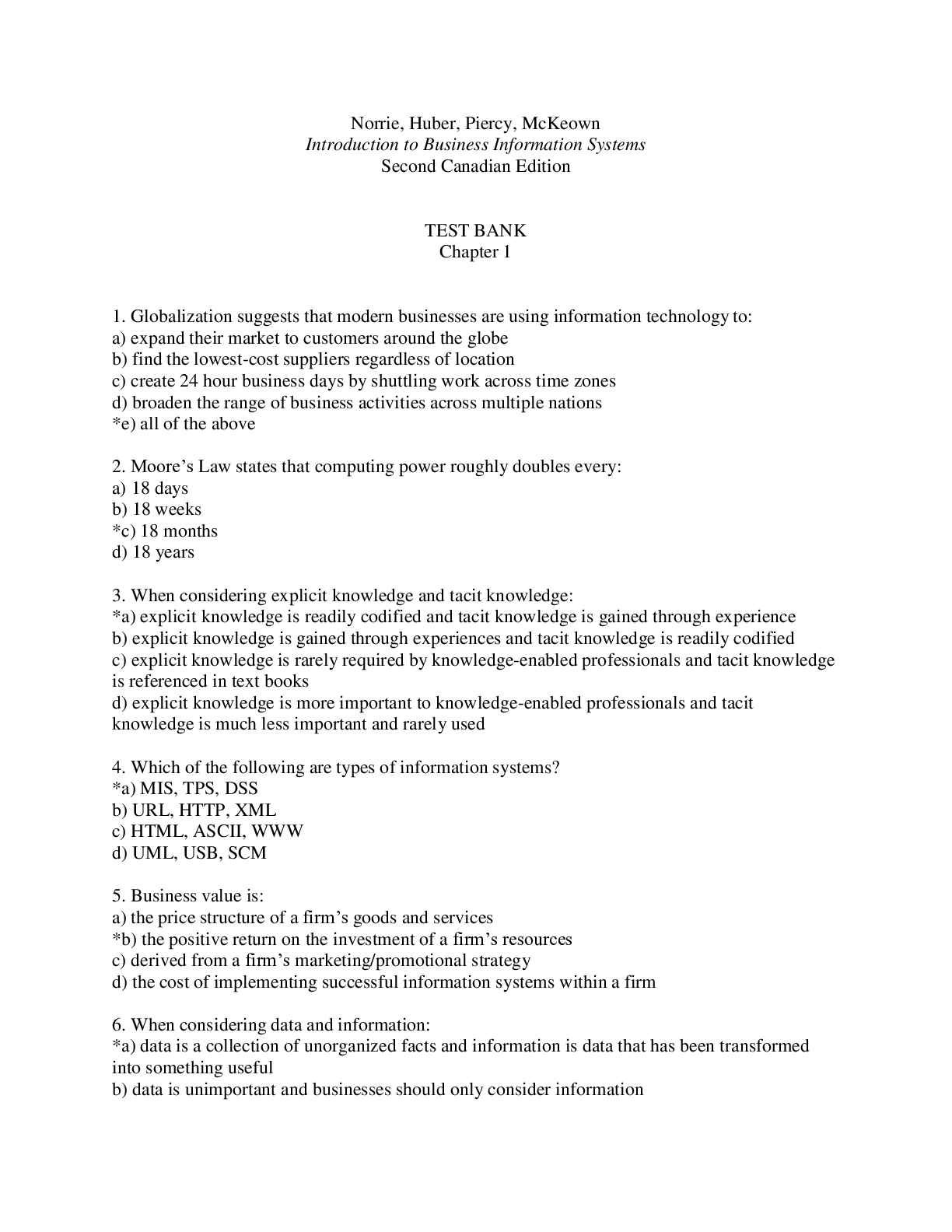





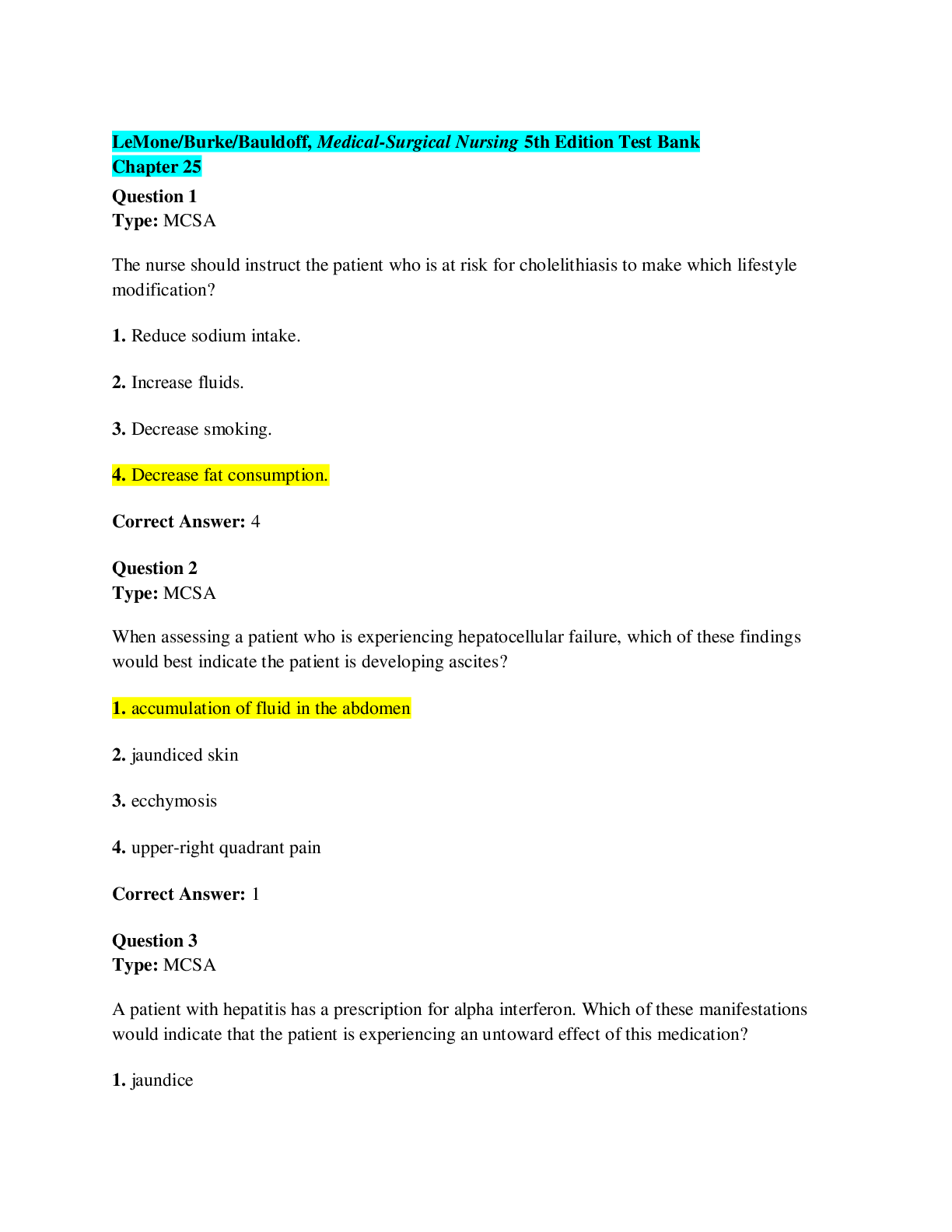

.png)
.png)
.png)

